NFT Lending Market Analysis: Blend Holds the Largest Market Share
Original Title: 《NFT Lending Volume Reaches All-Time High, But not For Long》
Original Author: Gabe Parker, Galaxy
Compiled by: Kate, Marsbit
The NFT lending market recently surged to an all-time high since the peak of the 2022 bull market. In just the second quarter of 2023, the lending volume of NFTs exceeded $197 million, largely driven by the new lending platform Blend launched by Blur in early May this year. Blend is now the most widely used NFT lending platform, with over 2,300 borrowers and 15,000 lenders. Since its inception, Blend has accumulated a total borrowing amount of approximately $921 million, with around 62,000 loans. Although a small number of users account for the majority of Blend's activity, the increase in active users is a promising sign of adoption. This report briefly outlines the NFT lending ecosystem and highlights the profound impact of Blend's overnight success on other areas.
Key Points
• In Q2 2023, the weekly NFT lending volume reached a historic high of $197 million
• Year-to-date, the cumulative NFT lending volume has grown by 270%
• The total number of users in the NFT lending market is increasing
• The top ten lending institutions account for 48% of Blend's total lending volume
• The top ten borrowers account for 26% of Blend's total lending volume
• 68% of Blend's lending is driven by airdrop farmers
Overview of NFT Lending Dynamics
Blend and other NFT lending protocols provide a convenient solution for NFT holders looking to leverage their assets for instant liquidity while also offering lenders the opportunity to earn returns on their ETH. These protocols typically serve as peer-to-peer lending markets where users can lock their NFTs as collateral in a custodial smart contract and request ETH loans secured by the underlying value of the locked NFTs for a specified term. Borrowers receive bids from potential lenders and provide specific collateral and interest rate parameters, allowing lenders to choose the most attractive lending terms. Among various collateral and interest rate parameters, there is a liquidation level that sets a loan-to-value (LTV) threshold relative to the underlying NFT collateral value. In the event of liquidation, the custodial smart contract transfers the NFT collateral to the lender to settle the outstanding loan amount. Once the loan is activated, the borrowed ETH can be used to purchase additional NFTs, effectively establishing a leveraged NFT position.
In our NFT DeFi report, we emphasize that NFT holders often use peer-to-peer lending markets to hedge their long positions in popular NFTs. "In fact, NFT-collateralized lending acts as a prepaid put option: if the true value of the NFT falls below the loan amount during the lending period, the debtor has an incentive not to repay the loan, thereby losing the NFT worth the loan amount." By holding the NFT (locking it in the contract), borrowers create a combination of a put + long position, similar to a call option.
NFT Lending Landscape
After the NFT market peaked in April 2022, there was a significant surge in NFT lending activity. Initially, the market was primarily dominated by Bend and NFTfi, which held 63% and 23% market shares, respectively. However, the NFT lending landscape changed in December 2022, with new competitors like X2Y2, Arcade, and Paraspace entering the space, leading to increased competition in the NFT lending market. As a result, the market shares of Bend and NFTfi dropped to 12% and 19%, respectively, while Paraspace, X2Y2, and Arcade held market shares of 35%, 25%, and 6%. While this was significant at the time, it pales in comparison to the disruption we have seen since the emergence of Blend. Since its launch in May, Blend has captured approximately 95% of NFT lending volume.

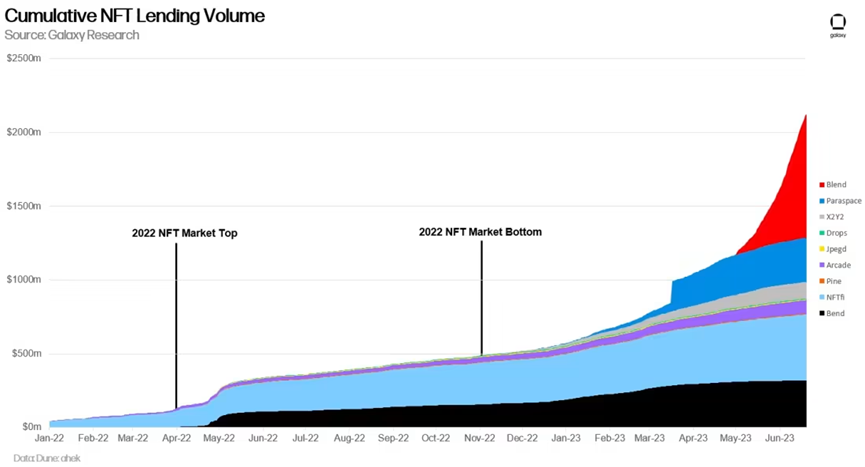
Before Blend's emergence, NFT lending volume was slowly recovering from a historical low in November 2022. Year-to-date, cumulative NFT lending volume has grown by 270%. Blend's overnight success pushed lending activity to new highs within weeks. Notably, Blend's sales in the past six weeks ($921 million) have surpassed the annual sales of most competitors.
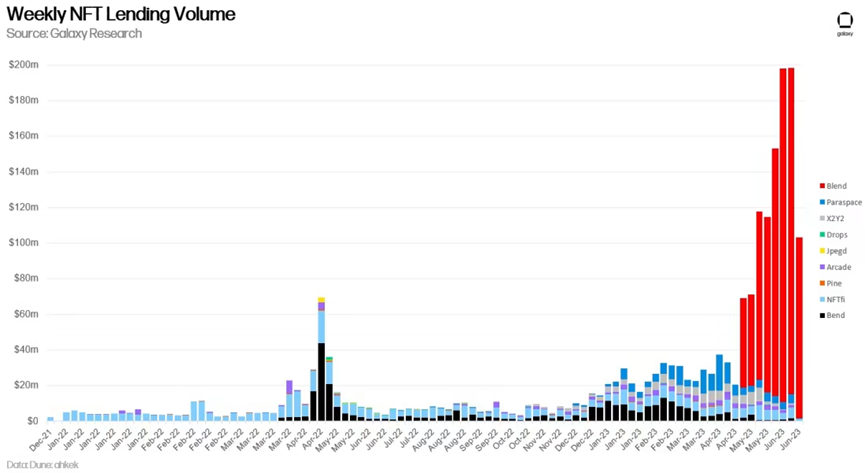
Active Blend
Like other NFT lending platforms, Blend has taken a conservative approach by limiting support to a select few major NFT collections that are lower risk due to increased liquidity. At launch, Blend only allowed users to borrow ETH using Miladys, Azukis, and Wrapped Punks as collateral. Blend eventually diversified the selection of lending collateral to include other major blue-chip NFTs; however, Azuki remains the primary collection used as collateral (706 active loans).
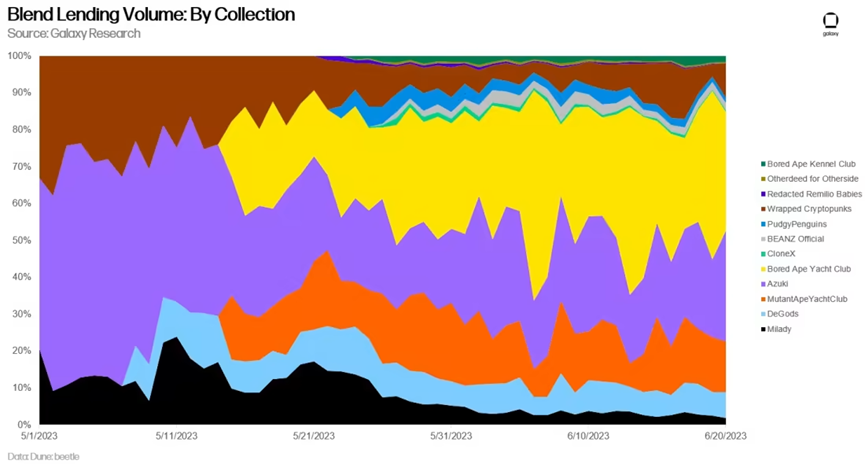
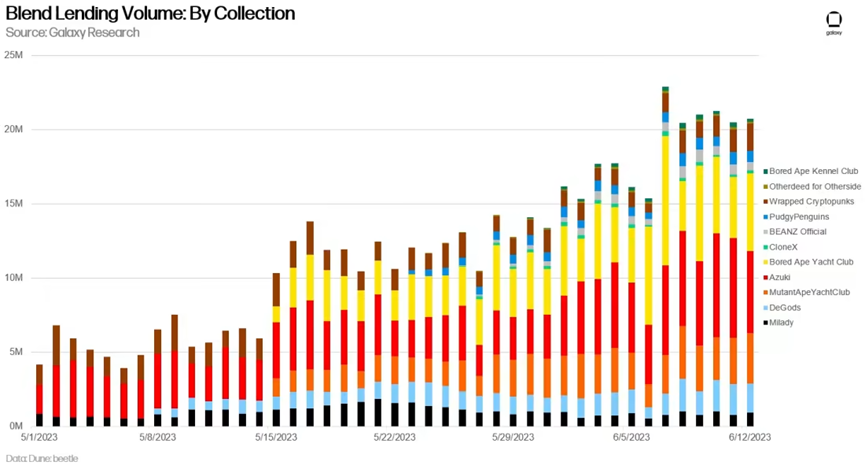
Lenders and Borrowers on Blend
In our NFT Marketplace Update, we previously noted that Blur's user base is primarily composed of ETH whales. Similar to Blur, Blend's lending base is also primarily made up of ETH whale players. For example, the top ten lending institutions on Blend contribute 48% of the platform's total lending volume. Among these lenders, wallet 0x8BC stands out as a major participant, accounting for about 7% of the ETH lent to borrowers on Blur. This user's wallet holds approximately $19.7 million and has a substantial token allocation, primarily composed of ETH. Notably, wallet 0x8BC received the third-largest Blur token airdrop, totaling 2.97 million tokens (worth about $1 million at today's prices). Many top lending institutions received significant airdrops in the first season of BLUR, indicating that the initial airdrop's biggest beneficiaries are still the most active users on the platform, possibly incentivized by the upcoming second season airdrop.
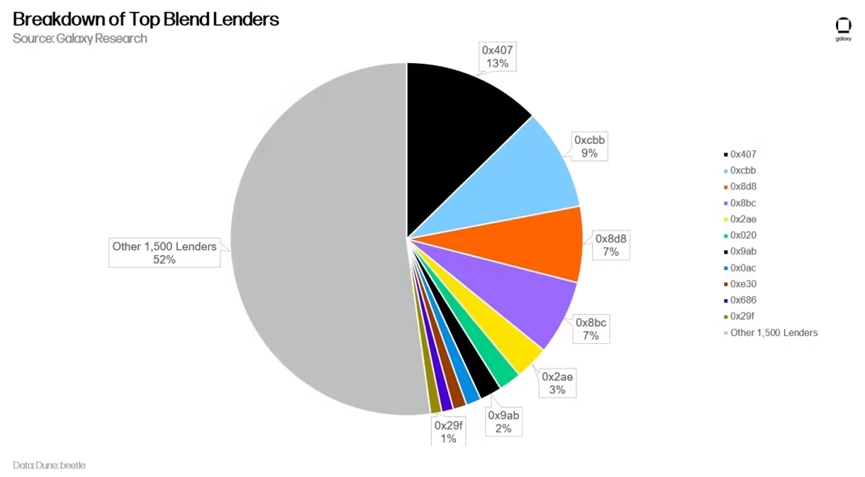
Analysis of the wallets of top Blend borrowers indicates that these users also have substantial NFT collections, ranging from six to seven figures. It should be noted that experienced NFT collectors often diversify their respective collections across multiple wallets, so the cumulative NFT holdings recorded for each user below may be much larger.

Compared to Blend's lending institutions, the concentration of borrowers on Blend is lower and more diverse, with the largest borrower accounting for no more than 4.5% of the total borrowing volume. For reference, Blend's largest lender accounts for 13% of the total lending volume. Clearly, there are more borrowers than lenders on Blend.
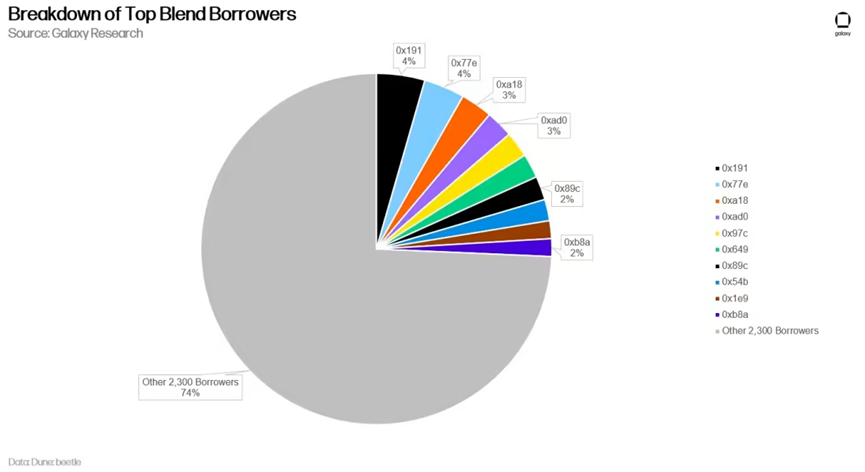
Although Blend's lending volume is more distributed among users, the types of users borrowing remain wealthy NFT collectors and ETH whales. This finding reinforces our view that NFT lending is predominantly a tool used by experienced, wealthy NFT collectors.

Blend's Impact on Blur
Despite the increase in NFT lending activity on Blend, Blur's overall trading volume (excluding NFTs purchased with loans) is declining. Since May 1, 2023, Blend's weekly cumulative lending volume has exceeded Blur's weekly trading volume by 43%.

The Longevity of NFT Lending in a Bear Market
A key trend indicates that the current lending volume is inorganic and may be unsustainable. For Blend, over 68% of approved loans have an annual interest rate of 0%, suggesting that users are more focused on airdrops, earning points by accepting bids. On the other hand, 20% of loans have an annual interest rate between 10% and 20%, indicating that borrowers are eager to accumulate points for the upcoming airdrop. This surge in activity will benefit Blur in the short term, but when these lending incentives cease, user stickiness and trading volume may decline. Therefore, Blend will face user retention challenges similar to other NFT lending platforms without token incentives. After the second season airdrop, Blend's lending volume is likely to decline significantly due to the lack of attractive loan terms, as lenders will have no incentive to accept 0% annual interest rate terms. The reduction in lenders will inevitably lead to a decrease in borrowers on Blend, resulting in reduced lending activity.
Blend's direct impact on the NFT ecosystem will positively influence NFT collectors by educating new users about airdrop dynamics. Additionally, offering competitive lending products to mature NFT collectors can foster new trading strategies around liquid NFT collections. The financialization of NFTs will be one of many developments that push the industry to new heights by attracting a new breed of profit-driven collectors, which will increase overall liquidity in the NFT market. However, in a bear market, NFT lending will struggle to find a sustainable product-market fit, as key metrics such as cumulative trading volume and the number of traders are at historical lows. While Blend's case study highlights only one segment of NFT collectors, lending is typically a leverage tool used by experienced traders. Thus, in the short term, NFT lending products are unlikely to meet the needs of retail collectors.









